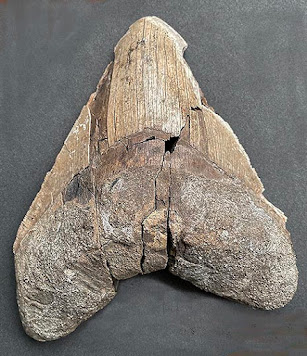This current post is a much-needed update of my post of June 22, 2014 (10 years ago). The name “megalodon” is well known to collectors of the world’s largest fossil shark teeth.
“Megalodon” was previously identified by most workers as Carcharocles megalodon. It is now identified by the experts to be Otodus megalodon (meaning “big tooth). This seems like a minor issue, but to paleontologists, it is important to always have the most correct identification for any fossil.
Otodus megalodon is an extinct species of giant mackerel shark that lived approximately 23 to 3.6 million years ago (equivalent to earliest Miocene to middle Pliocene time).
The body of Otodus megalodon is only known from fragment remains. The most recent estimate of its full body size is a maximum length of about 59 feet = the world’s largest fish (fossil or extant). This shark had wide distribution in shallow-temperate and tropical seas. Teeth from this shark species are especially well known from “Shark Tooth Hill” near Bakersfield, California, the Caribbean region (including Florida and the coastal Carolinas), western Europe, the Mediterranean area, western South America, western Europe, west Africa, India (only very localized), Japan, New Zealand, and South Australia.
The current classification of this fossil (extinct) shark is:
CLASS: Chondrichthyes
FAMILY Otodontidae
GENUS: Otodus
SPECIES: O. megalodon
The teeth of this shark are heavy, stout, and have a triangular symmetrical shape, with very fine serrations along the sides. Both sides of the tooth bottoms are strongly projected downward. Over the surface of both sides of the teeth, there are some to many distinct, vertical lines aligned with the serrations.
Front and back views of a tooth of Otodus megalodon, 5.25 inches long ("slant length" nearly 5.5 inches); most likely from the Pliocene Towsley Formation in the western San Gabriel Mountains. It was found by a student (Mike P.) who was an avid fossil collector. Just for the fun it, he roamed the heavily vegetated and very steep slopes of the San Gabriel Mountains, just north of the San Fernando Valley, southern California. He had an uncanny ability for being able to fine extremely interesting fossils. He gave me this shark tooth, as well as some other shark teeth that he found, because he knew how much I appreciate fossils.
Otodus megalodon, front view of a tooth 4 inches long ("slant height" nearly 4.5 inches) inches long); Miocene, 20 million years old, Hawthorne Formation?, coastal South Carolina.
Otodus megalodon, front view of a tooth 1.9 inches long ("slant height" nearly 2 inches long); Miocene, 15 million years old, Bone Valley sediments, Fort Meyer, Florida.
REFERENCES CONSULTED
Dupra, D. L. 1985. Sharktooth Hill. California Geology, July issue, pp. 147-154.
Kelley, K.V., Jr. 1971. Kelley’s guide to fossil sharks. Second edition. M & M Printing, Ruskin, Florida, 38 pp.
Wikipedia, 2024.




No comments:
Post a Comment